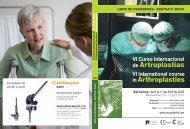cadera / hip - Active Congress.......
cadera / hip - Active Congress.......
cadera / hip - Active Congress.......
Create successful ePaper yourself
Turn your PDF publications into a flip-book with our unique Google optimized e-Paper software.
JUEVES / THURSDAY<br />
242<br />
from the medial tibial plateau, which often<br />
leaves the defect on the lateral side of the<br />
tibia that requires a bone graft. Use of a<br />
long-stem tibial component and screws in<br />
the tibial tray securely fi xes the tibial component,<br />
and obviates the use of fi xed structural<br />
bone graft.<br />
Ligament Release Technique and Differential<br />
Balancing<br />
Stability is assessed fi rst in fl exion by holding<br />
the knee at 90° fl exion and maximally<br />
internally rotating the extremity to stress<br />
the medial side of the knee, then maximally<br />
externally rotating the extremity to evaluate<br />
the lateral side of the knee. A medial opening<br />
greater than 4 mm, and a lateral opening<br />
greater than 5 mm, is considered abnormally<br />
lax, whereas an opening less than 2 mm on<br />
either side is considered abnormally tight.<br />
The knee then is extended and stability is assessed<br />
in full extension by applying varus and<br />
valgus stress to the knees. A medial opening<br />
greater than 2 mm and a lateral opening<br />
greater than 3mm is considered abnormally<br />
lax, whereas an opening less than 1 mm on<br />
either side is considered abnormally tight.<br />
Tight laterally in fl exion only<br />
In knees that are too tight laterally in fl exion,<br />
but not in extension, the LCL is released in<br />
continuity with the periosteum and synovial<br />
attachments to the bone. When this lateral<br />
tightness is associated with internal rotational<br />
contracture, the popliteus tendon attachment<br />
to the femur also is released. The iliotibial<br />
band and lateral posterior capsule should not<br />
be released in this situation because they<br />
provide lateral stability only in extension.<br />
Tight laterally in fl exion and extension<br />
The only structures that provide passive stability<br />
in fl exion are the LCL and the popliteus tendon<br />
complex, so knees that are tight laterally in<br />
fl exion and extension have popliteus tendon or<br />
LCL release (or both). Stability is tested after<br />
adjusting tibial thickness to restore ligament<br />
tightness on the lateral side of the knee. Ad-<br />
ditional releases are done only as necessary<br />
to achieve ligament balance. Any remaining<br />
lateral ligament tightness usually occurs in the<br />
extended position only, and is addressed by<br />
releasing the iliotibial band fi rst, then the lateral<br />
posterior capsule if needed. The iliotibial band<br />
is approached subcutaneously and released<br />
extrasynovially, leaving its proximal and distal<br />
ends attached to the synovial membrane.<br />
Tight laterally in extension only<br />
In knees that initially are too tight laterally<br />
in extension, but not in fl exion, the LCL and<br />
popliteus tendon are left intact, and the<br />
iliotibial band is released. If this does not<br />
loosen the knee enough laterally, the lateral<br />
posterior capsule is released. The LCL and<br />
popliteus tendon rarely, if ever, are released<br />
in this type of knee.<br />
Finally, the tibial component thickness is<br />
adjusted to achieve proper balance between<br />
the medial and lateral sides of the knee. Anteroposterior<br />
stability and femoral rollback are<br />
assessed, and posterior cruciate substitution<br />
is done if necessary to achieve acceptable<br />
posterior stability.<br />
MEDIAL PIVOT KNEE<br />
ARTHROPLASTY<br />
J. D. Blaha, M.D.<br />
University of Michigan.<br />
Medical School, USA<br />
Design of total knee prostheses is predicated<br />
on knowledge of the kinematics of the normal<br />
knee. Designs that more closely mimic the<br />
normal might reasonably be expected to perform<br />
more normally for the patient. For many<br />
years the knee joint has been viewed as a<br />
“four-bar link” in which the ligaments (specifi -<br />
cally the cruciate ligaments) guide the motion<br />
of the knee in such a way that “rollback” occurs.<br />
(Rollback is the progressive posterior





